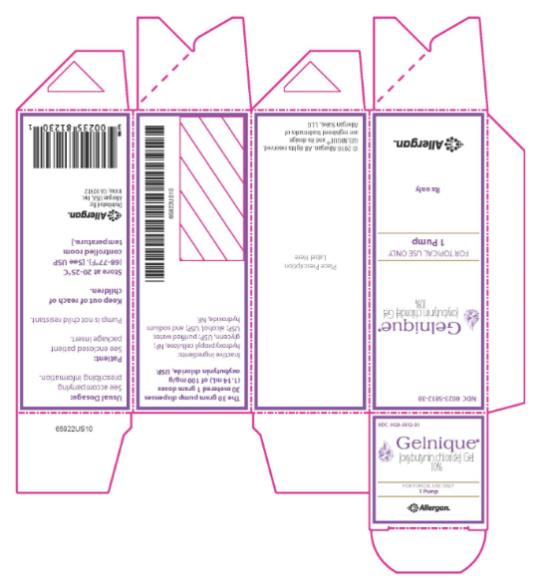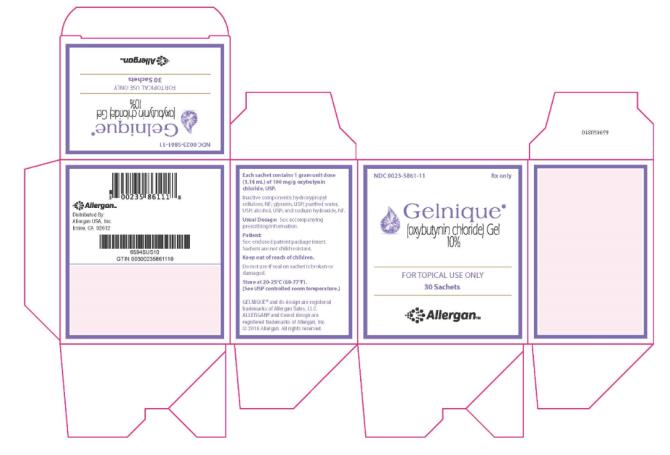GELNIQUE- oxybutynin chloride gel
GELNIQUE by
Drug Labeling and Warnings
GELNIQUE by is a Prescription medication manufactured, distributed, or labeled by Allergan, Inc.. Drug facts, warnings, and ingredients follow.
Drug Details [pdf]
-
HIGHLIGHTS OF PRESCRIBING INFORMATION
GELNIQUE®
(oxybutynin chloride) gel 10%
Rx only
These highlights do not include all the information needed to use GELNIQUE safely and effectively.
See full prescribing information for GELNIQUE.
GELNIQUE (oxybutynin chloride) 10% gel
Initial U.S. Approval: 1975
INDICATIONS AND USAGE
GELNIQUE is a muscarinic antagonist indicated for the treatment of overactive bladder with symptoms of urge urinary incontinence, urgency, and frequency. (1)
DOSAGE AND ADMINISTRATION
- Apply contents of one sachet or one actuation of the metered-dose pump of GELNIQUE once daily to dry, intact skin on the abdomen, upper arms/shoulders, or thighs. (2)
- Rotate application sites, avoiding use of the same site on consecutive days. (2)
- GELNIQUE is for topical application only and should not be ingested. (2)
DOSAGE FORMS AND STRENGTHS
Gel: 10% (3)
CONTRAINDICATIONS
WARNINGS AND PRECAUTIONS
- Urinary Retention: Use caution in patients with clinically significant bladder outflow obstruction because of the risk of urinary retention. (5.1)
- Gastrointestinal Disorders: Use caution in patients with gastrointestinal obstructive disorders or decreased intestinal motility because of the risk of gastric retention. Use caution in patients with gastroesophageal reflux and/or those taking drugs that can cause or exacerbate esophagitis. (5.2)
- Angioedema: Angioedema has been reported with oral oxybutynin use. If symptoms of angioedema occur, discontinue GELNIQUE and initiate appropriate therapy. (5.3)
- Skin Hypersensitivity: Discontinue GELNIQUE in patients with skin hypersensitivity. (5.4)
- Central Nervous System Effects: Somnolence has been reported with GELNIQUE. Advise patients not to drive or operate heavy machinery until they know how GELNIQUE affects them. (5.5)
- Skin Transference: Advise patients to cover the application site with clothing if skin-to-skin contact at the application site is anticipated. Wash hands immediately after product application. (5.6)
- Flammable Gel: Contains alcohol-based gel. Avoid open fire or smoking until the gel has dried. (5.7)
- Myasthenia gravis: Avoid use in patients with myasthenia gravis, a disease characterized by decreased cholinergic activity at the neuromuscular junction. (5.8)
ADVERSE REACTIONS
The most common adverse reactions (incidence > 5% and > placebo) were dry mouth, urinary tract infection, and application site reactions. (6)
To report SUSPECTED ADVERSE REACTIONS, contact Allergan at 1-800-678-1605 or contact the FDA at 1-800-FDA-1088 or www.fda.gov/medwatch.DRUG INTERACTIONS
Other Anticholinergics (muscarinic antagonists): Concomitant use with other anticholinergic agents may increase the frequency and/or severity of dry mouth, constipation, blurred vision and other anticholinergic pharmacological effects. (7.1)
See 17 for PATIENT COUNSELING INFORMATION and FDA-approved patient labeling.
Revised: 3/2019
- Apply contents of one sachet or one actuation of the metered-dose pump of GELNIQUE once daily to dry, intact skin on the abdomen, upper arms/shoulders, or thighs. (2)
-
Table of Contents
FULL PRESCRIBING INFORMATION: CONTENTS*
1 INDICATIONS AND USAGE
2 DOSAGE AND ADMINISTRATION
3 DOSAGE FORMS AND STRENGTHS
4 CONTRAINDICATIONS
5 WARNINGS AND PRECAUTIONS
5.1 Urinary Retention
5.2 Use in Patients with Gastrointestinal Disorders
5.3 Angioedema
5.4 Skin Hypersensitivity
5.5 Central Nervous System Effects
5.6 Skin Transference
5.7 Flammable Gel
5.8 Exacerbation of Symptoms of Myasthenia Gravis
6 ADVERSE REACTIONS
6.1 Clinical Trials Experience
6.2 Postmarketing Experience
7 DRUG INTERACTIONS
7.1 Other Anticholinergics
7.2 Cytochrome P450 Inhibitors
8 USE IN SPECIFIC POPULATIONS
8.1 Pregnancy
8.2 Lactation
8.4 Pediatric Use
8.5 Geriatric Use
10 OVERDOSAGE
11 DESCRIPTION
12 CLINICAL PHARMACOLOGY
12.1 Mechanism of Action
12.3 Pharmacokinetics
13 NONCLINICAL TOXICOLOGY
13.1 Carcinogenesis, Mutagenesis, Impairment of Fertility
14 CLINICAL STUDIES
16 HOW SUPPLIED/STORAGE AND HANDLING
17 PATIENT COUNSELING INFORMATION
- * Sections or subsections omitted from the full prescribing information are not listed.
-
1 INDICATIONS AND USAGE
GELNIQUE is a muscarinic antagonist indicated for the treatment of overactive bladder with symptoms of urge urinary incontinence, urgency and frequency [see Clinical Studies (14)].
-
2 DOSAGE AND ADMINISTRATION
The contents of one sachet or one actuation of the metered-dose pump of GELNIQUE should be applied once daily to dry, intact skin on the abdomen, upper arms/shoulders, or thighs. Application sites should be rotated. Application of GELNIQUE should not be made to the same site on consecutive days [see Clinical Pharmacology (12.3)].
GELNIQUE is for topical application only and should not be ingested.
- 3 DOSAGE FORMS AND STRENGTHS
-
4 CONTRAINDICATIONS
The use of GELNIQUE is contraindicated in the following conditions:
- Urinary retention
- Gastric retention
- Uncontrolled narrow-angle glaucoma
- Known serious hypersensitivity reaction to GELNIQUE, oxybutynin, or to any of the components of GELNIQUE [see Warnings and Precautions (5.3, 5.4)].
- Urinary retention
-
5 WARNINGS AND PRECAUTIONS
5.1 Urinary Retention
Administer GELNIQUE with caution in patients with clinically significant bladder outflow obstruction because of the risk of urinary retention. [see Contraindications (4)]
5.2 Use in Patients with Gastrointestinal Disorders
Administer GELNIQUE with caution to patients with gastrointestinal obstructive disorders because of the risk of gastric retention. [see Contraindications (4)]
GELNIQUE, like other anticholinergic drugs, may decrease gastrointestinal motility and should be used with caution in patients with conditions such as ulcerative colitis or intestinal atony. GELNIQUE should be used with caution in patients who have gastroesophageal reflux and/or who are concurrently taking drugs (such as bisphosphonates) that can cause or exacerbate esophagitis.
5.3 Angioedema
Angioedema requiring hospitalization and emergency medical treatment has occurred with the first or subsequent doses of oral oxybutynin. In the event of angioedema, oxybutynin-containing product should be discontinued and appropriate therapy promptly provided.
5.4 Skin Hypersensitivity
In a controlled clinical trial of skin sensitization, 1 of 200 patients (0.5%) demonstrated skin hypersensitivity to GELNIQUE. Patients who develop skin hypersensitivity to GELNIQUE should discontinue drug treatment.
5.5 Central Nervous System Effects
GELNIQUE is associated with anticholinergic central nervous system (CNS) effects. A variety of CNS anticholinergic effects have been reported, including headache, dizziness, somnolence, confusion and hallucinations. Patients should be monitored for signs of anticholinergic CNS effects, particularly after beginning treatment. Advise patients not to drive or operate heavy machinery until they know how GELNIQUE affects them. If a patient experiences anticholinergic CNS effects, drug discontinuation should be considered. [See Adverse Reactions (6.1, 6.2)]
5.6 Skin Transference
Transfer of oxybutynin to another person can occur when vigorous skin-to-skin contact is made with the application site. To minimize the potential transfer of oxybutynin from GELNIQUE-treated skin to another person, patients should cover the application site with clothing after the gel has dried if direct skin-to-skin contact at the application site is anticipated [see Clinical Pharmacology (12.3)]. Patients should wash their hands immediately after application of GELNIQUE.
5.7 Flammable Gel
GELNIQUE is an alcohol-based gel and is therefore flammable. Avoid open fire or smoking until gel has dried.
5.8 Exacerbation of Symptoms of Myasthenia Gravis
Avoid use of GELNIQUE in patients with myasthenia gravis, a disease characterized by decreased cholinergic activity at the neuromuscular junction. If experiencing exacerbation of symptoms of myasthenia gravis, oxybutynin- containing product should be discontinued and appropriate therapy promptly provided.
-
6 ADVERSE REACTIONS
Because clinical trials are conducted under widely varying conditions, adverse reaction rates observed in the clinical trials of a drug cannot be directly compared to rates in the clinical trial of another drug and may not reflect the rates observed in practice.
6.1 Clinical Trials Experience
The safety of GELNIQUE was evaluated in 789 patients (389 randomized to GELNIQUE 1 g and 400 randomized to placebo) during a randomized, placebo-controlled, double-blind, 12-week clinical efficacy and safety study. A subset of these 789 patients (N = 216) participated in the 14-week open-label safety extension that followed the placebo-controlled study. Of 216 patients in the safety extension, 107 were randomized to placebo gel during the double-blind, placebo-controlled 12-week study. In the combined double-blind, placebo-controlled study and the open-label safety extension, a total of 496 patients were exposed to at least one dose of GELNIQUE. Four hundred thirty-one (431) patients received at least 12 weeks of GELNIQUE treatment and 85 patients received 26 weeks of GELNIQUE treatment. The study population primarily consisted of Caucasian women (approximately 90%) with an average age of 59 years who had overactive bladder with urge urinary incontinence.
Table 1 lists adverse reactions that were reported in the randomized, double-blind, placebo-controlled 12-week study in greater than 2% of patients treated with GELNIQUE and at an incidence greater than placebo.
Table 1: Common Adverse Reactions in the Randomized, Double-blind, Placebo-controlled 12-Week Study (> 2% and > placebo) Adverse Reaction GELNIQUE 1 gram
N = 389
n (%)Placebo
N = 400
n (%)Dry mouth 29 (7.5) 11 (2.8) Urinary tract infection 27 (6.9) 17 (4.3) Application site reactions* 21 (5.4) 4 (1.0) Upper respiratory tract infection 21 (5.4) 20 (5.0) Dizziness 11 (2.8) 4 (1.0) Nasopharyngitis 11 (2.8) 9 (2.3) Fatigue 8 (2.1) 4 (1.0) Gastroenteritis viral 8 (2.1) 7 (1.8) * Includes application site pruritus, dermatitis, papules, anesthesia, erythema, irritation, pain and papules Other common adverse reactions that were reported in ≥ 1% of GELNIQUE-treated patients were headache (1.5%), constipation (1.3%), and pruritus (1.3%). Application site pruritus (2.1%) and application site dermatitis (1.8%) were the most commonly reported application site reactions. A majority of adverse reactions were described as mild or moderate in intensity, except for two patients reporting severe headache.
The most common adverse reaction leading to drug discontinuation was application site reaction (0.8% with GELNIQUE versus 0.3% with placebo).
The most common adverse reactions reported during the 14-week open-label extension study were application site reactions (6.0%) and dry mouth (1.9%). The most common reason for premature discontinuation was application site reactions (9 patients or 4.2%). Two of these 9 patients experienced application site reactions of severe intensity (dermatitis, urticaria, and erythema).
6.2 Postmarketing Experience
The following adverse reactions have been identified during post approval use of GELNIQUE. Because these reactions are reported voluntarily from a population of uncertain size, it is not always possible to reliably estimate their frequency or establish a causal relationship to drug exposure.
Nervous System Disorders: Memory impairment, dizziness, somnolence, confusion
Psychiatric Disorders: Delirium, hallucinations -
7 DRUG INTERACTIONS
No specific drug-drug interaction studies have been performed with GELNIQUE.
-
8 USE IN SPECIFIC POPULATIONS
8.1 Pregnancy
Risk Summary
There are no studies with topical or oral oxybutynin use in pregnant women to inform any drug-associated risks of adverse development outcomes. No adverse developmental outcomes were observed in animal reproduction studies when oxybutynin chloride was administered to pregnant rats and rabbits during organogenesis at approximately 50 and 1 times, respectively, the maximum human dose based on body surface area (see Data).
In the general U.S. population, the estimated background risk of major birth defects and miscarriages in clinically recognized pregnancies is 2-4% and 15-20% respectively.
Data
Animal Data
Subcutaneous administration of oxybutynin chloride to rats at doses up to 25 mg/kg (approximately 50 times the human exposure based on body surface area) and to rabbits at doses up to 0.4 mg/kg (approximately 1 times the human exposure based on body surface area) throughout the period of organogenesis revealed no evidence of harm to the fetus.
8.2 Lactation
Risk Summary
There is no information on the presence of oxybutynin or its metabolites in human milk, its effects on milk production or on the breast fed child. The developmental and health benefits of breastfeeding should be considered along with the mother’s clinical need for GELNIQUE and any potential adverse effects on the breastfed child from GELNIQUE or from the underlying maternal condition.
8.4 Pediatric Use
The safety and effectiveness of GELNIQUE 10% have not been established in pediatric patients.
8.5 Geriatric Use
Of the 496 patients exposed to GELNIQUE in the randomized, double-blind, placebo-controlled 12-week study and the 14-week safety extension study, 188 patients (38%) were 65 years of age and older. No overall differences in safety or effectiveness were observed between these patients and younger patients, but greater sensitivity of some older individuals cannot be ruled out [see Clinical Pharmacology (12.3)].
-
10 OVERDOSAGE
Overdosage with oxybutynin has been associated with anticholinergic effects including central nervous system excitation, flushing, fever, dehydration, cardiac arrhythmia, vomiting, and urinary retention. Oral ingestion of 100 mg oxybutynin chloride in association with alcohol has been reported in a 13-year-old boy who experienced memory loss, and in a 34-year-old woman who developed stupor, followed by disorientation and agitation on awakening, dilated pupils, dry skin, cardiac arrhythmia, and retention of urine. Both patients recovered fully with symptomatic treatment.
Plasma concentrations of oxybutynin begin to decline 24 hours after GELNIQUE application. If overexposure occurs, monitor patients until symptoms resolve.
-
11 DESCRIPTION
Oxybutynin is an antispasmodic, antimuscarinic agent. GELNIQUE (oxybutynin chloride) is a clear and colorless hydroalcoholic gel containing 100 mg oxybutynin chloride per gram of gel. GELNIQUE is available in a metered-dose pump that dispenses 30 metered 1 gram doses or in a 1 gram (1.14 mL) unit dose. Each dose contains 100 mg oxybutynin chloride. Oxybutynin is delivered as a racemate of R- and S- isomers. Chemically, oxybutynin chloride is d, l (racemic) 4-(Diethylamino)-2-butynyl (±)-α-phenylcyclohexaneglycolate hydrochloride.
The empirical formula of oxybutynin is C22H31NO3HCl. Its structural formula is:

Oxybutynin chloride is a white powder with a molecular weight of 393.95.
Inactive ingredients in GELNIQUE are alcohol, USP; glycerin, USP; hydroxypropyl cellulose, NF; sodium hydroxide, NF; and purified water, USP.
-
12 CLINICAL PHARMACOLOGY
12.1 Mechanism of Action
Oxybutynin acts as a competitive antagonist of acetylcholine at postganglionic muscarinic receptors, resulting in relaxation of bladder smooth muscle. Oxybutynin is a racemic (50:50) mixture of R- and S- isomers. Antimuscarinic activity resides predominantly with the R- isomer. The active metabolite, N-desethyloxybutynin, has pharmacological activity on the human detrusor muscle that is similar to that of oxybutynin in in vitro studies.
12.3 Pharmacokinetics
Absorption
Oxybutynin is transported across intact skin and into the systemic circulation by passive diffusion across the stratum corneum. Steady-state concentrations are achieved within 7 days of continuous dosing. Absorption of oxybutynin is similar when GELNIQUE is applied to the abdomen, upper arm/shoulders or thighs. Mean plasma concentrations during a randomized, crossover study of the three recommended application sites in 39 healthy men and women are shown in Figure 1.
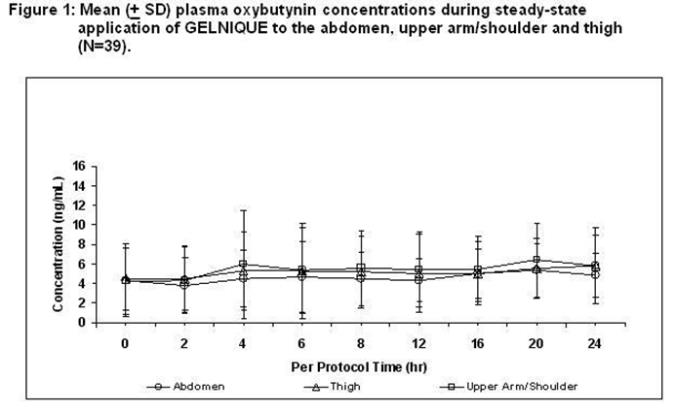
Average steady-state plasma oxybutynin concentrations were 4.7, 5.2, and 5.5 ng/mL for the abdomen, upper arm/shoulder and thigh application sites, respectively (Table 2).
Table 2: Mean (SD) steady-state pharmacokinetic parameters for oxybutynin following GELNIQUE application to the abdomen, upper arm/shoulder and thigh (N = 39).
Application SiteAUC0-24
(nghr/mL)Cmax
(ng/mL)Cavg
(ng/mL)Abdomen 112.7 (58.00) 6.8 (3.93) 4.7 (2.39) Upper Arm/Shoulder 133.8 (81.58) 8.3 (5.97) 5.5 (3.37) Thigh 125.1 (84.67) 7.0 (4.95) 5.2 (3.50) Distribution
Oxybutynin is widely distributed in body tissues following systemic absorption. The volume of distribution was estimated to be 193 L after intravenous administration of 5 mg oxybutynin chloride.
Metabolism
Oxybutynin is metabolized primarily by the cytochrome P450 enzyme systems, particularly CYP3A4, found mostly in the liver and gut wall. Metabolites include phenylcyclohexylglycolic acid, which is pharmacologically inactive, and N-desethyloxybutynin (DEO), which is pharmacologically active.
Transdermal administration of oxybutynin bypasses the first-pass gastrointestinal and hepatic metabolism, reducing the formation of the N-desethyloxybutynin metabolite. Only small amounts of CYP3A4 are found in skin, limiting pre-systemic metabolism during transdermal absorption. The AUC ratio of N-desethyloxybutynin metabolite to parent compound following multiple transdermal applications is approximately 1:1 for GELNIQUE.
Following intravenous administration, the elimination half-life of oxybutynin is approximately 2 hours. After the final steady-state dose of GELNIQUE, oxybutynin and N-desethyloxybutynin demonstrated biphasic elimination with plasma concentrations beginning to decrease 24 hours after dosing. Elimination was more rapid between 24 and 48 hours after dosing, during which time plasma concentrations of oxybutynin and N-desethyloxybutynin declined by about one-half. This rapid elimination phase was followed by a more prolonged terminal elimination phase. The apparent elimination half-lives including the terminal elimination phase were 64 hours and 82 hours for oxybutynin and DEO, respectively.
Excretion
Oxybutynin is extensively metabolized by the liver, with less than 0.1% of the administered dose excreted unchanged in the urine. Less than 0.1% of the administered dose is excreted as the metabolite N-desethyloxybutynin.
Person-to-Person Transference
The potential for dermal transfer of oxybutynin from a treated person to an untreated person was evaluated in a single-dose study where subjects dosed with GELNIQUE engaged in vigorous contact with an untreated partner for 15 minutes, either with (N = 14 couples) or without (N = 12 couples) clothing covering the application area. The untreated partners not protected by clothing demonstrated detectable plasma concentrations of oxybutynin (mean Cmax = 0.94 ng/mL). Two of the 14 untreated subjects participating in the clothing-to-skin contact regimen had measurable oxybutynin plasma concentrations (Cmax ≤ 0.1 ng/mL) during the 48 hours following contact with treated subjects; oxybutynin was not detectable with the remaining 12 untreated subjects.
Use of Sunscreen
The effect of sunscreen on the absorption of oxybutynin when applied 30 minutes before or 30 minutes after GELNIQUE application was evaluated in a single-dose randomized crossover study (N = 16). Concomitant application of sunscreen, either before or after GELNIQUE application, had no effect on the systemic exposure of oxybutynin.
Showering
The effect of showering on the absorption of oxybutynin was evaluated in a randomized, steady-state crossover study under conditions of no shower, or showering 1, 2 or 6 hours after GELNIQUE application (N = 20). The results of the study indicate that showering after one hour does not affect the overall systemic exposure to oxybutynin.
Race
The effect of race on the pharmacokinetics of GELNIQUE has not been studied.
Specific Populations:
Geriatric: Available data suggest that there are no significant differences in the pharmacokinetics of oxybutynin based on geriatric status in patients following administration of GELNIQUE [see Use in Specific Populations (8.5)].
Pediatric: The pharmacokinetics of oxybutynin and N-desethyloxybutynin have not been evaluated in individuals younger than 18 years of age [see Use in Specific Populations (8.4)].
Gender: Available data suggest that there are no significant differences in the pharmacokinetics of oxybutynin based on gender in healthy volunteers following administration of GELNIQUE.
-
13 NONCLINICAL TOXICOLOGY
13.1 Carcinogenesis, Mutagenesis, Impairment of Fertility
A 24-month study in rats at dosages of oxybutynin chloride of 20, 80 and 160 mg/kg showed no evidence of carcinogenicity. These doses are approximately 6, 25 and 50 times the maximum exposure in humans taking an oral dose, based on body surface area. Oxybutynin chloride showed no increase of mutagenic activity when tested in Schizosaccharomyces pompholiciformis, Saccharomyces cerevisiae, and Salmonella typhimurium test systems. Reproduction studies with oxybutynin chloride in the mouse, rat, hamster, and rabbit showed no definite evidence of impaired fertility.
-
14 CLINICAL STUDIES
The efficacy and safety of GELNIQUE were evaluated in a single randomized, double-blind, placebo-controlled, parallel group 12-week study for the treatment of overactive bladder with symptoms of urge incontinence, urgency and frequency. Key entry criteria included adults with symptomatic overactive bladder with an average of ≥ 4 incontinence episodes in a 3-day period and at least 8 micturitions per day. Patients were randomized to daily applications of GELNIQUE 1 gram or matching placebo gel. A total of 389 patients received GELNIQUE and 400 patients received placebo gel. The majority of patients were Caucasian (86.3%) and female (89.2%), with a mean age of 59.4 years (range: 18 to 88 years). The average duration of urinary incontinence was approximately 8.5 years and approximately 75% of patients had no prior pharmacological treatment for urinary incontinence.
Patients treated with GELNIQUE experienced a statistically significant decrease in the number of urinary incontinence episodes per day from baseline to endpoint compared with placebo (p < 0.0001) as well as a decrease in the average daily urinary frequency (p = 0.0017) and an increase in the average urine volume per void (p = 0.0018).
Mean and median change from baseline in daily incontinence episodes (primary endpoint), urinary frequency, and urinary void volume (secondary endpoints) between placebo and GELNIQUE are summarized in Table 3.
Table 3: Mean and median change from baseline for incontinence episodes, urinary frequency, and urinary void volume at Week 12 (LOCF*). Parameter GELNIQUE 1 gram
(N = 389)Placebo
(N = 400)Mean (SD) Median Mean (SD) Median Daily Incontinence Episodes Baseline 5.4 (3.26) 4.7 5.4 (3.28) 4.7 Change from baseline -3.0 (2.73) -2.7 -2.5 (3.06) -2.0 Mean difference [GELNIQUE – placebo]
(95% CI)-0.5 (-0.14, -0.87) P-value vs. placebo < 0.0001 Daily Urinary Frequency Baseline 12.4 (3.34) 11.7 12.2 (3.32) 11.3 Change from baseline -2.7 (3.21) -2.7 -2.0 (2.82) -1.7 P-value vs. placebo 0.0017 Urinary Void Volume (mL) Baseline 163.4 (65.85) 160.1 167.9 (68.40) 160.6 Change from Baseline 21.0 (65.33) 11.5 3.8 (53.79) 0.0 P-value vs. placebo 0.0018 *Last-Observation-Carried-Forward statistical imputation for missing data -
16 HOW SUPPLIED/STORAGE AND HANDLING
Metered-Dose Pump: Metered-dose pump dispenser capable of delivering 30 metered 1 gram doses.
Carton of 1 metered-dose Pump (NDC: 0023-5812-30)
Unit Dose: Heat-sealed sachet containing 1 gram (1.14 mL) of GELNIQUE gel for topical use.
Carton of 30 Sachets (NDC: 0023-5861-11)
Storage
Store at 20-25°C (68-77°F). [See USP controlled room temperature.] Protect from moisture and humidity. Apply immediately after the sachets are opened and contents expelled or dose delivered from dispenser. Discard used sachets and empty dispensers in household trash in a manner that prevents accidental application or ingestion by children, pets, or others.
Keep out of reach of children.
-
17 PATIENT COUNSELING INFORMATION
[See FDA-Approved Patient Labeling](Patient Information)
Instructions for Use
GELNIQUE is for topical application only and should not be ingested.
GELNIQUE should not be applied to recently shaved skin surfaces. Patients should wash hands immediately after product application. Application sites should not be subject to showering or water immersion for 1 hour after product application. Application sites should be covered with clothing if close skin-to-skin contact at the application site is anticipated.
Alcohol based gels are flammable. Avoid open fire or smoking until the gel has dried.
Important Anticholinergic Adverse Reactions
Patients should be informed that anticholinergic (antimuscarinic) agents, such as GELNIQUE, may produce clinically significant adverse reactions related to anticholinergic pharmacological activity including:
- Urinary retention and constipation.
- Heat prostration (due to decreased sweating) when anticholinergics such as GELNIQUE are used in a hot environment.
- Dizziness or blurred vision. Patients should be advised to exercise caution in decisions to engage in potentially dangerous activities until GELNIQUE’s effects have been determined.
- Drowsiness that may be worsened by alcohol.
Distributed By:
Allergan USA, Inc.
Madison, NJ 07940
© 2019 Allergan. All rights reserved.
Gelnique® is a registered trademark of Allergan Sales, LLC.
v1.1USPI5812
- Urinary retention and constipation.
-
PATIENT PACKAGE INSERT
FDA-Approved Patient Labeling
PATIENT INFORMATION
GELNIQUE [JEL NEEK]
(oxybutynin chloride) 10% gel TopicalIMPORTANT: For use on the skin only (topical). Do not use GELNIQUE in or near your eyes, nose, or mouth.
What is GELNIQUE?
GELNIQUE is a prescription medicine used to treat the symptoms of overactive bladder:
- Urge urinary incontinence (a strong need to urinate with leaking or wetting accidents).
- Urgency (a strong need to urinate right away).
- Frequency (need to urinate often).
Do not use GELNIQUE if:
- your bladder does not empty or does not empty completely when you urinate (urinary retention).
- your stomach empties slowly or incompletely after a meal (gastric retention).
- you have uncontrolled narrow-angle glaucoma (high pressure in your eye). Tell your doctor if you have glaucoma or a family history of glaucoma.
- you are allergic to oxybutynin or any of the ingredients in GELNIQUE. See the end of this Patient Information leaflet for a complete list of ingredients in GELNIQUE.
Before using GELNIQUE, tell your healthcare provider about all of your medical conditions, including, if you:
- have problems emptying your bladder completely
- have a gastrointestinal obstruction (blockage in the digestive system)
- have constipation or difficulty emptying your bowels
o have ulcerative colitis (inflamed bowels)
o have gastroesophageal reflux disease or esophagitis (inflamed esophagus, the tube between your mouth and stomach)
- have Myasthenia Gravis (condition that causes muscle weakness)
- are pregnant or plan to become pregnant
- are breastfeeding or plan to breastfeed
- medicines called “bisphosphonates” to treat osteoporosis
- medicines called “anticholinergics”
Especially tell your doctor if you take:
Ask your doctor or pharmacist for a list of these medicines if you are not sure if you take any of these medicines.
Know the medicines you take including prescription and non-prescription medicines, vitamins, and herbal supplements.
Keep a list of them and show it to your healthcare provider and pharmacist when you get a new medicine.
How should I use GELNIQUE?
-
GELNIQUE is for skin use only.
- Use GELNIQUE exactly as your healthcare provider tells you to use it.
- GELNIQUE should only be applied to dry intact skin on your stomach (abdomen), upper arms, shoulders, or thighs.
- Do not put GELNIQUE on open sores, recently shaved skin, or skin with rashes.
- You should change your application site every day. Do not use the same site 2 days in a row. Changing application sites every day can help reduce your chance of getting skin irritation.
- GELNIQUE contains alcohol and is flammable. Avoid fire, flames or smoking until GELNIQUE has dried.
- After applying GELNIQUE, wash your hands with soap and water right away.
- Cover the application site with clothing if skin-to-skin contact between another person and the application site is expected.
- If someone else is exposed to GELNIQUE by direct contact with the gel or at the application site, that person should wash the area of contact with soap and water as soon as possible.
- If you get GELNIQUE in your eyes, rinse your eyes right away with warm, clean water to flush out any GELNIQUE.
- GELNIQUE may be used with sunscreen.
Applying GELNIQUE:
1. Selecting your application site:
Apply GELNIQUE only to 1 of the shaded areas shown in the figure below: (See Figure A)- stomach (abdomen)
- upper arms
- shoulder
- thigh
Figure A:

- Wash the area where GELNIQUE will be applied with mild soap and water. Allow the area to dry completely.
- Wash your hands with soap and water.
2. How to use the GELNIQUE packets (sachets):
- Find the notch at the top of your GELNIQUE packet. Tear off the top of the GELNIQUE packet at the notch (See Figure B).
Figure B:
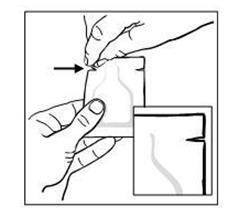
- Squeeze all of the GELNIQUE out of the packet onto your hand (palm or fingertips) or you can squeeze all of the GELNIQUE from the packet right onto the application site (See Figure C).
- Squeeze from the bottom of the packet toward the open end. Repeat until the packet is empty. The amount of GELNIQUE in each packet will be about the size of a nickel. Apply GELNIQUE to your skin (shown in Figure C).
Figure C:
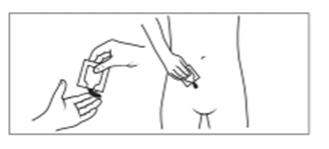
- Wash your hands with soap and water right away.
- Throw away the packet in the trash out of the reach of children to avoid accidental exposure.
3. How to use the GELNIQUE pump:
You must prime the GELNIQUE pump before you use it for the first time.
To prime the pump:
- To prime GELNIQUE, hold the pump upright (see Figure D) and fully press down (depress) the pump several times with your thumb or index finger until you see gel come out (typically, this will take four or more depressions). After gel is observed, fully depress the pump one more time, and discard this portion of the product to assure precise dose delivery. The pump is now primed and GELNIQUE is ready to use.
Figure D:
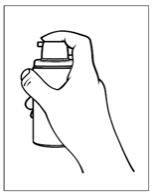
Dispensing your dose of GELNIQUE:
- Place your hand under the GELNIQUE pump (see Figure E). Press the pump all the way down 1 time. You can also place the pump right over the application site then press the pump all the way down 1 time to dispense your dose. The amount of gel dispensed with one full pump equals one daily dose of GELNIQUE.
- The amount of gel that equals your dose will be about the size of a nickel.
Figure E:

- Apply the gel to your skin in the selected body area (see Figure A) and wash your hands with soap and water right away.
- After you have used GELNIQUE pump 30 times, throw it away.
What should I avoid while using GELNIQUE?
- GELNIQUE can cause tiredness, drowsiness, dizziness or blurred vision. Do not drive, operate machinery, or do other dangerous activities until you know how GELNIQUE affects you.
- Do not take a bath, swim, shower, exercise, or get the application site wet for at least 1 hour after you apply your dose.
What are the possible side effects of GELNIQUE?
GELNIQUE can cause serious side effects including:- Allergic reactions, including allergic skin reactions
The most common side effects of GELNIQUE include:
- dry mouth
- redness, rash, itching, pain at the application site
- dizziness
- headache
- constipation
- itching
- tiredness
- Other side effects that have been seen with drugs containing oxybutynin, like GELNIQUE, include: dizziness and blurred vision, drowsiness that may be increased with alcohol (beer, wine, or hard liquor), and decreased sweating that may lead to overheating.
Tell your healthcare provider if you have any side effect that bothers you or that does not go away. These are not all the possible side effects of GELNIQUE. For more information, ask your healthcare provider or pharmacist.
Call your doctor for medical advice about side effects. You may report side effects to the FDA at 1-800-FDA-1088.
How should I store GELNIQUE?
- Store GELNIQUE at 68°F to 77°F (20°C to 25°C).
- Safely throw away GELNIQUE in household trash. Be careful to prevent accidental exposure to children or pets.
- Keep GELNIQUE metered-dose pump and sachets in a dry place.
Keep GELNIQUE and all medicines out of the reach of children.
General information about GELNIQUE
Medicines are sometimes prescribed for purposes other than those listed in the Patient Information leaflet. Do not use GELNIQUE for a condition for which it was not prescribed. Do not give GELNIQUE to other people, even if they have the same symptoms you have. It may harm them.
You can ask your pharmacist or healthcare provider for information about GELNIQUE that is written for health professionals.
For more information about GELNIQUE call 1-800-678-1605 or go to www.GELNIQUE.com
What are the ingredients of GELNIQUE?
Active Ingredient: oxybutynin chloride
Inactive Ingredients: alcohol, USP; glycerin, USP; hydroxypropyl cellulose, NF; sodium hydroxide, NF; and purified water, USP.
This Patient Information has been approved by the U.S. Food and Drug Administration.
Distributed By:
Allergan USA, Inc.
Madison, NJ 07940© 2019 Allergan. All rights reserved.
Gelnique® is a registered trademark of Allergan Sales, LLC.
Revised: 03/2019v1.1PPI5812
- Urge urinary incontinence (a strong need to urinate with leaking or wetting accidents).
- PRINCIPAL DISPLAY PANEL
-
INGREDIENTS AND APPEARANCE
GELNIQUE
oxybutynin chloride gelProduct Information Product Type HUMAN PRESCRIPTION DRUG Item Code (Source) NDC: 0023-5812 Route of Administration TRANSDERMAL Active Ingredient/Active Moiety Ingredient Name Basis of Strength Strength OXYBUTYNIN CHLORIDE (UNII: L9F3D9RENQ) (OXYBUTYNIN - UNII:K9P6MC7092) OXYBUTYNIN CHLORIDE 100 mg in 1 g Inactive Ingredients Ingredient Name Strength ALCOHOL (UNII: 3K9958V90M) GLYCERIN (UNII: PDC6A3C0OX) HYDROXYPROPYL CELLULOSE (1600000 WAMW) (UNII: RFW2ET671P) SODIUM HYDROXIDE (UNII: 55X04QC32I) WATER (UNII: 059QF0KO0R) Packaging # Item Code Package Description Marketing Start Date Marketing End Date 1 NDC: 0023-5812-30 1 in 1 CARTON 04/01/2017 1 30 g in 1 BOTTLE, PUMP; Type 0: Not a Combination Product Marketing Information Marketing Category Application Number or Monograph Citation Marketing Start Date Marketing End Date NDA NDA022204 04/01/2017 GELNIQUE
oxybutynin chloride gelProduct Information Product Type HUMAN PRESCRIPTION DRUG Item Code (Source) NDC: 0023-5861 Route of Administration TRANSDERMAL Active Ingredient/Active Moiety Ingredient Name Basis of Strength Strength OXYBUTYNIN CHLORIDE (UNII: L9F3D9RENQ) (OXYBUTYNIN - UNII:K9P6MC7092) OXYBUTYNIN CHLORIDE 100 mg in 1 g Inactive Ingredients Ingredient Name Strength ALCOHOL (UNII: 3K9958V90M) GLYCERIN (UNII: PDC6A3C0OX) HYDROXYPROPYL CELLULOSE (1600000 WAMW) (UNII: RFW2ET671P) SODIUM HYDROXIDE (UNII: 55X04QC32I) WATER (UNII: 059QF0KO0R) Packaging # Item Code Package Description Marketing Start Date Marketing End Date 1 NDC: 0023-5861-11 30 in 1 CARTON 04/01/2017 1 1 g in 1 PACKET; Type 0: Not a Combination Product Marketing Information Marketing Category Application Number or Monograph Citation Marketing Start Date Marketing End Date NDA NDA022204 04/01/2017 Labeler - Allergan, Inc. (144796497)
Trademark Results [GELNIQUE]
Mark Image Registration | Serial | Company Trademark Application Date |
|---|---|
 GELNIQUE 87196781 5186582 Live/Registered |
Allergan Sales, LLC 2016-10-07 |
 GELNIQUE 77660922 3700307 Dead/Cancelled |
ALLERGAN SALES, LLC 2009-02-01 |
 GELNIQUE 77429789 3658979 Live/Registered |
ALLERGAN SALES, LLC 2008-03-24 |
© 2025 FDA.report
This site is not affiliated with or endorsed by the FDA.
